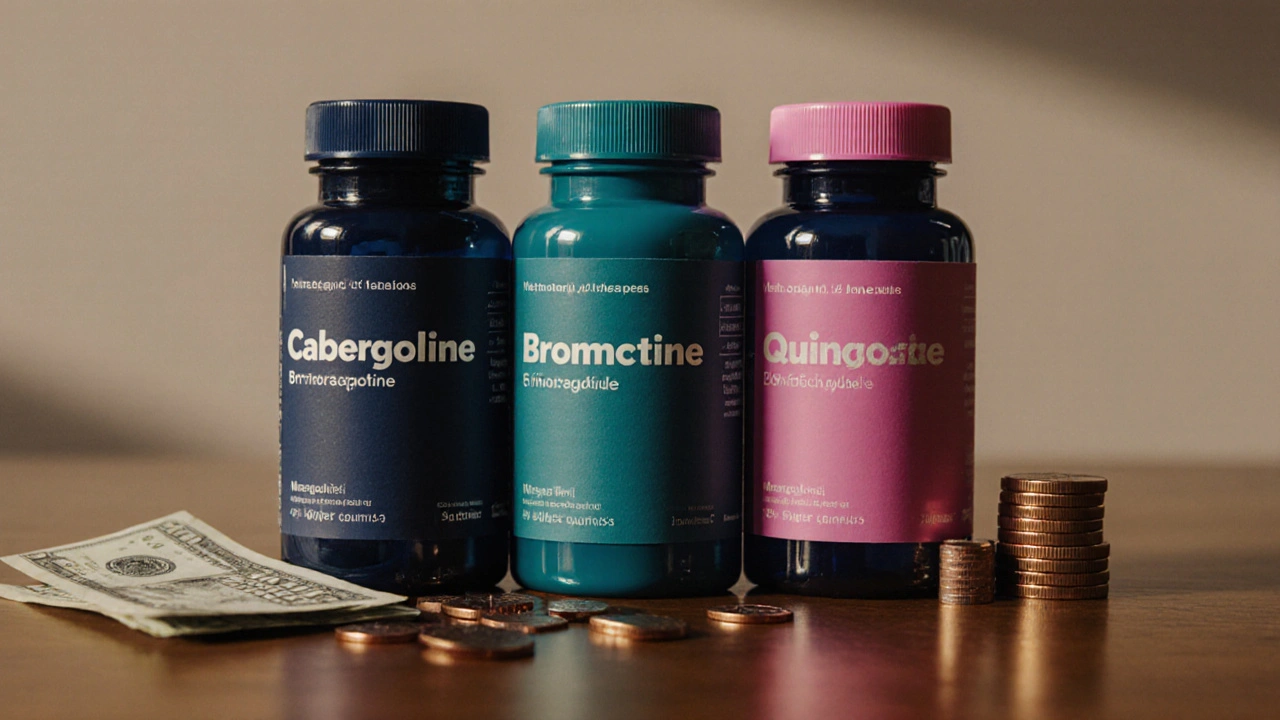Dostinex (Cabergoline) vs. Other Dopamine Agonists: Which Is Best for Hyperprolactinemia?

Dopamine Agonist Comparison Tool
Select Treatment Criteria
Quick Takeaways
- Dostinex (cabergoline) is the most potent dopamine agonist for lowering prolactin.
- Oral alternatives like bromocriptine and quinagolide work but often need higher doses.
- Cost and side‑effect profiles differ: cabergoline costs more but has fewer nausea issues.
- Choosing the right drug depends on indication, tolerance, and insurance coverage.
- Always discuss dosage adjustments with an endocrinologist.
Dostinex is a brand name for cabergoline, a long‑acting ergot‑derived dopamine D2 receptor agonist used primarily to treat hyperprolactinemia. By mimicking dopamine, it suppresses prolactin secretion from the pituitary, allowing tumor shrinkage and symptom relief.
High prolactin levels (hyperprolactinemia) can cause infertility, galactorrhea, menstrual disturbances, and, in men, erectile dysfunction. The most common cause is a prolactin‑secreting pituitary adenoma, or prolactinoma. While surgery is an option, medical therapy with dopamine agonists is first‑line for the overwhelming majority.
Why Compare Alternatives?
Patients and clinicians often ask: “If Dostinex works so well, why look elsewhere?” The answer lies in three practical jobs‑to‑be‑done:
- Find a cheaper option when insurance doesn’t cover Dostinex.
- Switch to a drug with a different side‑effect profile if cabergoline causes intolerable nausea or headaches.
- Identify a medication that can be used during pregnancy or in specific comorbidities.
Below we explore the most common alternatives, their pharmacology, dosing, and real‑world considerations.
Alternative Dopamine Agonists
All alternatives belong to the broader class of dopamine agonists, which bind to dopamine receptors to inhibit prolactin release. The key players are:
- Bromocriptine - a short‑acting ergot derivative approved for prolactinoma and Parkinson’s disease.
- Quinagolide - a non‑ergot oral agonist available in several European markets.
- Generic cabergoline - chemically identical to Dostinex but sold without brand markup.
- Lisuride - another ergot‑derived agent with a modest dopamine affinity.
- Pergolide - historically used for Parkinson’s, withdrawn in many countries due to valvular heart risk.
How the Drugs Stack Up
| Brand / Generic | Typical Daily Dose | FDA Status | Main Indication | Key Side‑effects |
|---|---|---|---|---|
| Dostinex (cabergoline) | 0.5-2mg weekly (split) | Approved | Prolactinoma, hyperprolactinemia | Nausea (rare), headache, possible valvulopathy (high dose) |
| Generic Cabergoline | 0.5-2mg weekly | Approved | Same as Dostinex | Similar to brand |
| Bromocriptine (Parlodel) | 2.5-10mg daily | Approved | Prolactinoma, Parkinson’s | GI upset, orthostatic hypotension, dizziness |
| Quinagolide (Norpro) | 25-75µg twice daily | Approved (EU) | Prolactinoma | Fatigue, insomnia, mild nausea |
| Lisuride | 0.5-1mg daily | Off‑label in many regions | Prolactinoma, migraine | Dry mouth, dizziness, occasional valvulopathy |
| Pergolide | 0.5-1mg daily | Withdrawn (US, EU) | Parkinson’s (historical) | Serious cardiac valve disease |

Key Decision Criteria
When weighing Dostinex against its peers, consider four core factors:
- Efficacy: Cabergoline achieves normal prolactin levels in ~85-90% of patients, outperforming bromocriptine (≈70%). Quinagolide sits in the middle.
- Dosing convenience: Weekly dosing of Dostinex reduces pill burden; bromocriptine requires multiple daily doses.
- Side‑effect tolerance: Nausea is common with bromocriptine; cabergoline’s main concerns are headaches and, at high cumulative doses (>5mg/day for >4years), valve thickening.
- Cost & insurance: Generic cabergoline can be 30‑40% cheaper than the brand. Bromocriptine is often the lowest‑priced option but may need higher daily doses.
Real‑World Scenarios
Imagine three patients who need a dopamine agonist:
- Emma, 28, wants to conceive. She needs a drug with a solid safety record in pregnancy. Cabergoline is the go‑to, as studies (e.g., 2021 endocrine journal) show no teratogenic effect at standard doses.
- Mark, 55, has mild heart murmur. His cardiologist advises against high‑dose cabergoline because of valve concerns. A low‑dose bromocriptine regimen may be safer, albeit with more GI side‑effects.
- Ravi, 40, lives in a country where cabergoline isn’t reimbursed. He opts for quinagolide, which is affordable locally and taken twice a day, achieving similar prolactin reduction.
These examples illustrate how the cabergoline alternatives fit different life circumstances.
Related Concepts and Next Steps
Understanding dopamine agonists also opens the door to adjacent topics such as hyperprolactinemia causes (thyroid disease, chest wall irritation), the role of prolactinoma imaging (MRI), and management of valvulopathy risk monitoring (annual echocardiogram for high‑dose users). After reading this, you might explore:
- “How to interpret prolactin lab results”
- “MRI criteria for pituitary adenoma size”
- “Pregnancy safety of dopamine agonists”
Practical Tips for Switching or Starting Therapy
- Start low, go slow. Begin with the lowest effective dose to minimise nausea.
- Monitor prolactin. Check serum levels after 4-6weeks; adjust dose accordingly.
- Cardiac surveillance. If cumulative cabergoline exceeds 3mg/week for >3years, schedule an echocardiogram.
- Coordinate with pharmacy. Verify insurance tier; generic options can shave off up to $150 per year.
- Document side‑effects. Use a simple diary; share with your endocrinologist for dose tweaks.
Frequently Asked Questions
Can I take cabergoline while pregnant?
Yes, many studies show that cabergoline (including Dostinex) does not increase birth defects when used at the usual prolactinoma dose. Always keep your obstetrician in the loop.
Why does bromocriptine cause more nausea than cabergoline?
Bromocriptine has a shorter half‑life and stronger peripheral dopamine activity, which stimulates the chemoreceptor trigger zone in the brain. Taking it with food and starting at 1.25mg can help.
Is quinagolide available in New Zealand?
No, quinagolide is not registered in NZ. Patients usually rely on Dostinex, generic cabergoline, or bromocriptine through special access schemes.
How often should I have an echocardiogram while on cabergoline?
If you stay under 2mg per week, a baseline echo is enough. Exceeding that, or using the drug for >4years, warrants an annual scan.
Can I switch from bromocriptine to cabergoline safely?
Yes. Typically, clinicians taper bromocriptine over 1-2weeks, then start cabergoline at 0.5mg weekly. Monitor prolactin and side‑effects during the transition.
What’s the price difference between Dostinex and generic cabergoline?
In Australia and the UK, Dostinex can cost about AUD180-200 for a month’s supply, while generic equivalents range from AUD115-130, representing a 30‑40% saving.

Scott Kohler
September 27, 2025 AT 22:17Ah, the illustrious cabergoline saga—clearly another chapter in the grand pharmaceutical cabal’s script. One might suspect that the relentless push for weekly dosing is designed to keep patients so complacent they never question the underlying motives. Of course, the efficacy numbers are presented with the kind of polished veneer only a well‑funded conglomerate could afford. Meanwhile, the modest side‑effect profile is conveniently highlighted to mask any deeper metabolic conspiracies. Rest assured, the only thing more pervasive than dopamine agonists is the omnipresent agenda behind them.
Brittany McGuigan
September 28, 2025 AT 14:57Well, y’all, let’s set the record straight—America doesn’t need some foreign pharma plot to tell us what to take. Our doctors already know the best option, and it’s not some overpriced brand that pretends to be superior. The cheap generic works just fine, and any claim otherwise is just another marketing gimmick. Ilk, we’re sicker of the hype than the disease.
Priya Vadivel
September 29, 2025 AT 07:37It is understandable that patients feel overwhelmed when confronted with a plethora of dopamine agonists, and the decision‑making process can be quite daunting, especially when each drug presents a unique profile of efficacy and tolerability. Cabergoline, marketed as Dostinex, consistently demonstrates superior prolactin suppression in clinical trials, achieving normalization in approximately eighty‑five to ninety percent of cases, which is a remarkable figure when compared to its counterparts. Bromocriptine, while historically significant, often requires higher daily doses and is notorious for causing gastrointestinal distress, a side‑effect that many patients find intolerable. Quinagolide offers a middle ground, providing effective prolactin reduction with a dosing schedule that is more frequent but still manageable for most individuals. Generic cabergoline mirrors the brand’s pharmacodynamics, yet it frequently presents a more affordable alternative, reducing the financial burden on patients without compromising therapeutic outcomes. Cost considerations, however, should not eclipse the importance of monitoring for valvular heart disease, especially in patients receiving cumulative doses that exceed the recommended thresholds. Regular echocardiographic surveillance is advisable for those on long‑term high‑dose regimens, as early detection of valve abnormalities can prevent serious complications. In addition, the risk of headache, while generally mild, should be communicated to patients so they can distinguish medication‑related symptoms from other etiologies. For individuals with pre‑existing cardiac murmurs, a cautious approach—perhaps initiating therapy with a low‑dose bromocriptine—may mitigate potential risks. Pregnancy presents another layer of complexity; numerous studies have confirmed that cabergoline does not increase teratogenic risk when used at standard doses, making it a preferred option for women desiring conception. Conversely, bromocriptine’s extensive safety data also support its use during pregnancy, though the higher incidence of nausea may affect adherence. It is also essential to consider patient preference regarding dosing frequency; the convenience of once‑weekly administration can significantly improve compliance, especially for those with busy lifestyles. The side‑effect profile of quinagolide, characterized by occasional fatigue and insomnia, may be less acceptable to patients who prioritize sleep quality. Moreover, regional availability plays a crucial role; for instance, quinagolide is not registered in certain countries, limiting its utility for some populations. Ultimately, shared decision‑making between the endocrinologist and the patient, informed by a thorough discussion of efficacy, side‑effects, cost, and lifestyle considerations, yields the most satisfactory therapeutic outcome. By integrating these multifaceted factors, clinicians can tailor treatment plans that not only normalize prolactin levels but also align with individual patient values and circumstances.
Dharmraj Kevat
September 30, 2025 AT 00:17Cabergoline reigns supreme the others merely whisper.
Lindy Fujimoto
September 30, 2025 AT 16:57Whoa, hold up! You just brushed off all the nuanced data, didn’t you? 😱 Let’s remember that individual tolerance varies wildly, and dismissing alternatives altogether can be risky. 🌟
darren coen
October 1, 2025 AT 09:37The weekly dosing truly eases the daily burden for many patients.
Jennifer Boyd
October 2, 2025 AT 02:17Absolutely, and that consistency often translates to better quality of life—cheers to finding the right rhythm! 🎉 Let’s keep encouraging each other to share experiences and support one another through the journey.
Lauren DiSabato
October 2, 2025 AT 18:57Honestly, if you’re still debating between bromocriptine and cabergoline, you’ve clearly missed the latest meta‑analysis. The data are crystal clear—cabergoline outperforms on every measurable endpoint, period. Anything else is just academic fluff.
Hutchins Harbin
October 3, 2025 AT 11:37While your confidence is admirable, let’s not overlook the importance of precise terminology; “outperforms” should be qualified with effect size and confidence intervals. Moreover, a balanced discussion acknowledges that certain patients experience intolerable side‑effects with cabergoline, necessitating alternative options. It’s also worth noting that the linguistic framing of “crystal clear” can oversimplify complex clinical realities. In short, a nuanced, evidence‑based approach serves both clinicians and patients better than sweeping assertions.
Benjamin Herod
October 4, 2025 AT 04:17The article drags on like an endless lecture, utterly tedious.
luemba leonardo brás kali
October 4, 2025 AT 20:57Indeed, the prose could benefit from tighter structuring and the removal of redundant clauses. A more concise presentation would enhance readability without sacrificing essential information.